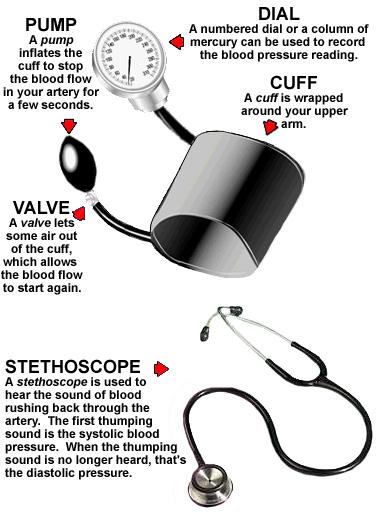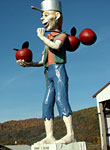Your Guide to Lowering Your High Blood Pressure
What Is Blood Pressure?
Blood pressure is the force of blood against the walls of arteries. Blood pressure is recorded as two numbers—the systolic pressure (as the heart beats) over the diastolic pressure (as the heart relaxes between beats). The measurement is written one above or before the other, with the systolic number on top and the diastolic number on the bottom. For example, a blood pressure measurement of 120/80 mmHg (millimeters of mercury) is expressed verbally as "120 over 80."
Normal blood pressure is less than 120 mmHg systolic and less than 80 mmHg diastolic.
High Blood Pressure
High blood pressure increases your chance (or risk) for getting heart disease and/or kidney disease, and for having a stroke. It is especially dangerous because it often has no warning signs or symptoms. Regardless of race, age, or gender, anyone can develop high blood pressure. It is estimated that one in every four American adults has high blood pressure. Once high blood pressure develops, it usually lasts a lifetime. You can prevent and control high blood pressure by taking action. In this section you will learn more about what high blood pressure is and what it does inside the body.
What Are High Blood Pressure and Prehypertension?
Blood pressure is the force of blood against the walls of arteries. Blood pressure rises and falls during the day. When blood pressure stays elevated over time, it is called high blood pressure.
The medical term for high blood pressure is hypertension. High blood pressure is dangerous because it makes the heart work too hard and contributes to atherosclerosis (hardening of the arteries). It increases the risk of heart disease and stroke, which are the first- and third-leading causes of death among Americans. High blood pressure also can result in other conditions, such as congestive heart failure, kidney disease, and blindness.
A blood pressure level of 140/90 mmHg or higher is considered high. About two-thirds of people over age 65 have high blood pressure. If your blood pressure is between 120/80 mmHg and 139/89 mmHg, then you have prehypertension. This means that you don't have high blood pressure now but are likely to develop it in the future. You can take steps to prevent high blood pressure by adopting a healthy lifestyle.
Those who do not have high blood pressure at age 55 face a 90 percent chance of developing it during their lifetimes. So high blood pressure is a condition that most people have at some point in their lives.Both numbers in a blood pressure test are important, but for people who are 50 or older, systolic pressure gives the most accurate diagnosis of high blood pressure. Systolic pressure is the top number in a blood pressure reading. It is high if it is 140 mmHg or above.
What is systolic blood pressure?
Systolic pressure is the force of blood in the arteries as the heart beats. It is shown as the top number in a blood pressure reading. High blood pressure is 140 and higher for systolic pressure. Diastolic pressure does not need to be high for you to have high blood pressure. When that happens, the condition is called "isolated systolic hypertension," or ISH.
Is isolated systolic high blood pressure common?
Yes. It is the most common form of high blood pressure for older Americans. For most Americans, systolic blood pressure increases with age, while diastolic increases until about age 55 and then declines. About 65 percent of hypertensives over age 60 have ISH. You may have ISH and feel fine. As with other types of high blood pressure, ISH often causes no symptoms. To find out if you have ISH — or any type of high blood pressure — see your doctor and have a blood pressure test. The test is quick and painless.
Is isolated systolic high blood pressure dangerous?
Any form of high blood pressure is dangerous if not properly treated. Both numbers in a blood pressure test are important, but, for some, the systolic is especially meaningful. That's because, for those persons middle aged and older, systolic pressure gives a better diagnosis of high blood pressure.
If left uncontrolled, high systolic pressure can lead to stroke, heart attack, congestive heart failure, kidney damage, blindness, or other conditions. While it cannot be cured once it has developed, ISH can be controlled.
Clinical studies have proven that treating a high systolic pressure saves lives, greatly reduces illness, and improves the quality of life. Yet, most Americans do not have their high systolic pressure under control.
Does it require special treatment?
Treatment options for ISH are the same as for other types of high blood pressure, in which both systolic and diastolic pressures are high. ISH is treated with lifestyle changes and/or medications. The key for any high blood pressure treatment is to bring the condition under proper control. Blood pressure should be controlled to less than 140/90 mmHg. If yours is not, then ask your doctor why. You may just need a lifestyle or drug change, such as reducing salt in your diet or adding a second medication.
What is diastolic blood pressure?
Diastolic pressure is the force of blood in the arteries as the heart relaxes between beats. It's shown as the bottom number in a blood pressure reading.
The diastolic blood pressure has been and remains, especially for younger people, an important hypertension number. The higher the diastolic blood pressure the greater the risk for heart attacks, strokes and kidney failure. As people become older, the diastolic pressure will begin to decrease and the systolic blood pressure begins to rise and becomes more important. A rise in systolic blood pressure will also increase the chance for heart attacks, strokes, and kidney failure. Your physician will use both the systolic and the diastolic blood pressure to determine your blood pressure category and appropriate prevention and treatment activities.
Why Is High Blood Pressure Important?
High blood pressure is dangerous because it makes the heart work too hard. It also makes the walls of the arteries hard. High blood pressure increases the risk for heart disease and stroke, the first- and third-leading causes of death for Americans. High blood pressure can also cause other problems, such as heart failure, kidney disease, and blindness.
Risk Factors
Risk factors are behaviors or conditions that can increase your chances of developing a disease. For instance, high blood pressure is a risk factor for heart disease and stroke.
There are other risk factors for heart disease and stroke. Most can be modified, though some cannot. The more risk factors you have, the greater your chances of developing disease. So it is important to take steps to prevent or control these risk factors.
Heart disease and stroke risk factors that can be controlled are:
- High blood pressure (hypertension)
- Abnormal cholesterol
- Tobacco use
- Diabetes
- Overweight
- Physical inactivity
Risk factors beyond your control are:
- Age (55 years and older for men and 65 years or older for women)
- Family history of early heart disease (having a mother or sister who has been diagnosed with heart disease before age 65, or a father or brother diagnosed before age 55) or family history of stroke
What Causes High Blood Pressure?
The causes of high blood pressure vary. Causes may include narrowing of the arteries, a greater than normal volume of blood, or the heart beating faster or more forcefully than it should. Any of these conditions will cause increased pressure against theartery walls. High blood pressure might also be caused by another medical problem. Most of the time, the cause is not known. Although high blood pressure usually cannot be cured, in most cases it can be prevented and controlled.
Who Can Develop High Blood Pressure?
High blood pressure is common. About 65 million American adults — nearly 1 in 3 — have high blood pressure. It is very common in African Americans, who may get it earlier in life and more often than whites. Many Americans tend to develop high blood pressure as they get older, but this is not a part of healthy aging. Middle-aged Americans face a 90% chance of developing high blood pressure during their lives. Others at risk for developing high blood pressure are the overweight, those with a family history of high blood pressure, and those with prehypertension (120–139/80–89 mmHg).
African Americans
High blood pressure occurs more often among African Americans than whites. It begins at an earlier age and is usually more severe. Further, African Americans have a higher death rate from stroke and kidney disease than whites. The good news is, treatment can control high blood pressure. In addition, lifestyle changes can prevent and control high blood pressure. These include losing weight if overweight (losing 10 lbs can help), increasing physical activity (walking 30 minutes per day can help), following a healthy eating plan, that emphasizes fruits, vegetables, and lowfat dairy foods, choosing and preparing foods with less salt and sodium, and if you drink alcoholic beverages, drinking in moderation. If lifestyle changes alone are not effective in keeping your blood pressure controlled, there are many blood pressure medications to help you.
High Blood Pressure Detection
You can find out if you have high blood pressure by having your blood pressure checked regularly. Most doctors will diagnose a person with high blood pressure on the basis of two or more readings, taken on several occasions. A consistent blood pressure reading of 140/90 mmHg or higher is considered high blood pressure, another term for hypertension.
Some people experience high blood pressure only when they visit the doctor's office. This condition is called "white-coat hypertension." If your doctor suspects this, you may be asked to monitor your blood pressure at home or asked to wear a device called an ambulatory blood pressure monitor. This device is usually worn for 24 hours and can take blood pressure every 30 minutes. In this section you will learn more about diagnosing high blood pressure.
How do I know if I have high blood pressure?
High blood pressure often has no signs or symptoms. The only way to find out if you have high blood pressure is to be tested for it. Using the familiar blood pressure cuff, your doctor or nurse can easily tell if your blood pressure is high.
How Is Blood Pressure Tested?
Having your blood pressure tested is quick and easy. Blood pressure is measured in millimeters of mercury (mmHg) and recorded as two numbers systolic pressure "over" diastolic pressure. For example, the doctor or nurse might say "130 over 80" as a blood pressure reading.
Both numbers in a blood pressure reading are important. As we grow older, systolic blood pressure is especially important.
To test your blood pressure, your doctor will use a familiar device with a long name. It is called a sphygmomanometer (pronounced sfig'-mo-ma-nom-e-ter), and may look something like this:

Some blood pressure testing devices use electronic instruments or digital readouts. In these cases, the blood pressure reading appears on a small screen or is signaled in beeps, and no stethoscope is used.
Tips for Having Your Blood Pressure Taken
- Don't drink coffee or smoke cigarettes 30 minutes before having your blood pressure measured.
- Before the test, sit for five minutes with your back supported and your feet flat on the ground.
- Rest your arm on a table at the level of your heart.
- Wear short sleeves so your arm is exposed.
- Go to the bathroom prior to the reading. A full bladder can change your blood pressure reading.
- Get two readings, taken at least two minutes apart, and average the results. Ask the doctor or nurse to tell you the blood pressure reading in numbers.
Categories for Blood Pressure Levels in Adults (Ages 18 Years and Older)
| Blood Pressure Level (mmHg) | Category | Systolic | | Diastolic |
| Normal | <> | and | <> |
| Prehypertension | 120-139 | or | 80-89 |
High Blood Pressure |
| Stage 1 Hypertension | 140–159 | or | 90–99 |
| Stage 2 Hypertension | 160 | or | 100 |
When systolic and diastolic blood pressures fall into different categories, the higher category should be used to classify blood pressure level. For example, 160/80 mmHg would be stage 2 hypertension (high blood pressure).
What device can I use to take my own blood pressure?
Tests at home can be done with the familiar blood pressure cuff and a stethoscope, or with an electronic monitor, such as a digital readout monitor. Also, be sure that the person who will use the device reads the instructions before taking blood pressure readings. Your doctor, nurse, or pharmacist can help you check the device and teach you how to use it. You also may ask for their help in choosing the right one for you. Blood pressure devices can be bought at various places, such as discount chain stores and pharmacies.
Prevention
You can take steps to prevent high blood pressure by adopting a healthy lifestyle. These steps include maintaining a healthy weight; being physically active; following a healthy eating plan, that emphasizes fruits, vegetables, and lowfat dairy foods; choosing and preparing foods with less salt and sodium; and, if you drink alcoholic beverages, drinking in moderation. In this section you will learn more about healthy lifestyle habits for preventing and controlling high blood pressure.
Healthy Eating
Research has shown that following a healthy eating plan can both reduce the risk of developing high blood pressure and lower an already elevated blood pressure.
For an overall eating plan, consider the DASH eating plan. "DASH" stands for "Dietary Approaches to Stop Hypertension," a clinical study that tested the effects of nutrients in food on blood pressure. Study results indicated that elevated blood pressures were reduced by an eating plan that emphasizes fruits, vegetables, and lowfat dairy foods and is low in saturated fat, total fat, and cholesterol. The DASH eating plan includes whole grains, poultry, fish, and nuts and has reduced amounts of fats, red meats, sweets, and sugared beverages.
A second clinical study, called "DASH-Sodium," looked at the effect of a reduced dietary sodium intake on blood pressure as people followed either the DASH eating plan or a typical American diet. Results showed that reducing dietary sodium lowered blood pressure for both the DASH eating plan and the typical American diet. The biggest blood pressure-lowering benefits were for those eating the DASH eating plan at the lowest sodium level (1,500 milligrams per day).
The DASH-Sodium study shows the importance of lowering sodium intake whatever your diet. But for a true winning combination, follow the DASH eating plan and lower your intake of salt and sodium.
Reduce Salt and Sodium in Your Diet
A key to healthy eating is choosing foods lower in salt and sodium. Most Americans consume more salt than they need. The current recommendation is to consume less than 2.4 grams (2,400 milligrams [mg]) of sodium a day. That equals 6 grams (about 1 teaspoon) of table salt a day. The 6 grams include ALL salt and sodium consumed, including that used in cooking and at the table. For someone with high blood pressure, the doctor may advise eating less salt and sodium, as recent research has shown that people consuming diets of 1,500 mg of sodium had even better blood pressure lowering benefits. These lower-sodium diets also can keep blood pressure from rising and help blood pressure medicines work better.
Maintaining a Healthy Weight
Being overweight increases your risk of developing high blood pressure. In fact, blood pressure rises as body weight increases. Losing even 10 pounds can lower blood pressure — and it has the greatest effect for those who are overweight and already have hypertension.
Being overweight or obese are also risk factors for heart disease. They increase your chance for developing high blood cholesterol and diabetes — two more major risk factors for heart disease.
Physical Activity
Being physically active is one of the most important steps you can take to prevent or control high blood pressure. It also helps reduce your risk of heart disease. It doesn't take a lot of effort to become physically active.
Limit Alcohol Intake
Drinking too much alcohol can raise blood pressure. It also can harm the liver, brain, and heart. Alcoholic drinks also contain calories, which matter if you are trying to lose weight. If you drink alcoholic beverages, have only a moderate amount — one drink a day for women; two drinks a day for men.
What counts as a drink?
12 ounces of beer (regular or light, 150 calories), or 5 ounces of wine (100 calories), or 1 ounces of 80-proof whiskey (100 calories).
Quitting Smoking
Smoking injures blood vessel walls and speeds up the process of hardening of the arteries. This applies even to filtered cigarettes. So even though it does not cause high blood pressure, smoking is bad for anyone, especially those with high blood pressure. If you smoke, quit. If you don't smoke, don't start. Once you quit, your risk of having a heart attack is reduced after the first year. So you have a lot to gain by quitting.
Q&A on Other Factors Affecting Blood Pressure
Do Vitamin Mineral Supplements such as Potassium, Calcium or Magnesium Help Lower Blood Pressure?
So far, research has shown that potassium does lower blood pressure. Studies have not indicated that calcium and magnesium supplements prevent high blood pressure. Here's the latest:
Potassium helps to prevent and control blood pressure. Be sure to get enough potassium in the foods you eat. Some good sources are various fruits,vegetables, dairy foods, and fish.
| Food | Serving Size | Potassium (mg) |
| Apricots, dried | 10 halves | 407 |
| Avocados, raw | 1 ounce | 180 |
| Bananas, raw | 1 cup | 594 |
| Beets, cooked | 1 cup | 519 |
| Brussel sprouts, cooked | 1 cup | 504 |
| Cantaloupe | 1 cup | 494 |
| Dates, dry | 5 dates | 271 |
| Figs, dry | 2 figs | 271 |
| Kiwi fruit, raw | 1 medium | 252 |
| Lima beans | 1 cup | 955 |
| Melons, honeydew | 1 cup | 461 |
| Milk, fat free or skim | 1 cup | 407 |
| Nectarines | 1 nectarine | 288 |
| Orange juice | 1 cup | 496 |
| Oranges | 1 orange | 237 |
| Pears (fresh) | 1 pear | 208 |
Peanuts dry roasted,
without salt | 1 ounce | 187 |
Potatoes, baked,
flesh and skin | 1 potato | 1081 |
| Prune juice | 1 cup | 707 |
| Prunes, dried | 1 cup | 828 |
| Raisins | 1 cup | 1089 |
| Spinach, cooked | 1 cup | 839 |
Tomato products,
canned, sauce | 1 cup | 909 |
| Winter squash | 1 cup | 896 |
| Yogurt plain, skim milk | 8 ounces | 579 |
Values were obtained from the USDA Nutrient Database for Standard References, Release 15 for Potassium, K (mg) content of selected foods per common measure
Calcium and Magnesium . These nutrients have not been consistently shown to prevent high blood pressure, but are important nutrients for overall good health.
Good sources of calcium are diary foods such as milk, yogurt, and cheese. Be sure to choose skim or lowfat varieties. Lowfat and nonfat dairy products have more calcium than the high fat versions.
| Food | Serving Size | Calcium (mg) |
| Broccoli, raw | 1 cup | 42 |
| Cheese, cheddar | 1 oz | 204 |
| Milk, fat free or skim | 1 cup | 301 |
| Perch | 3 oz | >116 |
| Salmon | 3 oz | 181 |
| Sardine | 3 oz | 325 |
| Spinach, cooked | 1 cup | 245 |
| Turnip greens, cooked | 1 cup | 197 |
| Tofu, soft | 1 piece | 133 |
| Yogurt plain, skim milk | 8 oz container | 452 |
Values were obtained from the USDA Nutrient Database for Standard References, Release 15 for Calcium, Ca (mg) content of selected foods per common measure.
You should get enough magnesium if you follow a healthy diet. Magnesium is found in whole grains, green leafy vegetables, nuts, and dry peas and beans

















































